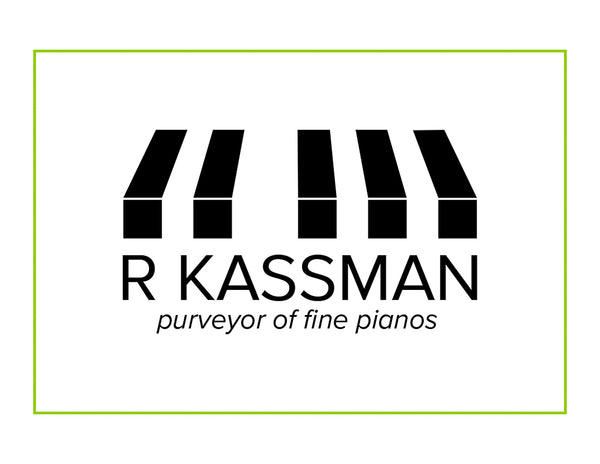
The Art of Piano Voicing: Enhancing the Tone and Touch of Your European Piano
An integral part of the European piano experience is the pursuit of a perfect balance between tone and touch. Each piano, whether it be a Steingraeber, Grotrian, or Estonia, possesses its unique tonal characteristics and responsiveness. To fully appreciate and optimize your piano's sound and playing experience, mastering the art of piano voicing is crucial.
Piano voicing is the process of adjusting the instrument's hammers to produce a consistent and desired tone. It involves careful modifications in the piano's action and hammers to refine the touch and responsiveness while respecting the brand's signature sound.
As you venture into the world of piano voicing and seek to reveal your piano's best qualities, Ric Overton at R. Kassman Piano in Berkeley, CA is an invaluable resource and partner for unlocking your European piano's full potential. Embrace the pursuit of tonal perfection and elevate your playing experience through the art of piano voicing.
The Importance of Piano Voicing: Unleashing the Full Potential of Your Instrument
The voice of a piano is what makes it a truly unique and personal instrument for every musician. Just as a skilled vocalist continuously refines their technique, a pianist must also explore the fine art of piano voicing to maximize their instrument's potential. Adequate voicing enhances the balance of tone across the keyboard, allowing it to produce an even and consistent sound. It also improves the player's ability to control the dynamic range, expression, and desired timbre, ultimately elevating the overall playing experience.
Understanding the Voicing Process: Tools, Techniques, and Precautions
The art of piano voicing is a delicate and intricate process, requiring both proficiency and appropriate tools. One of the primary voicing techniques involves adjusting the density and resilience of the piano hammers. Skilled piano technicians often use a process called "needling" to achieve this, which consists of carefully inserting thin needles into the hammer felt. This technique loosens the felt fibers, making them more flexible and allowing the hammer to interact with the strings optimally.
However, exercising caution during the voicing process is crucial. Inexperienced attempts to voice a piano may result in irreversible damage to the instrument. It is essential to collaborate with a skilled piano technician with proven expertise in voicing European pianos, including Steingraeber, Grotrian, and Estonia brands, to ensure the best results.
Preparing Your Piano for Voicing: The Significance of Regulation and Tuning
Before the actual voicing process can begin, it is crucial to ensure that your piano is in excellent playing condition. Two fundamental components make your piano ready for voicing - regulation and tuning.
- Regulation refers to the adjustment of your piano's action, ensuring that all its moving parts function harmoniously and efficiently.
- Tuning is the process of adjusting each string's tension to achieve the desired pitch.
Both regulation and tuning should be performed by a qualified piano technician to ensure accuracy and consistency. Once your piano is optimally regulated and tuned, it is ready for the voicing process.
Customizing Your Piano's Voice: Considering Your Preferences and Piano Characteristics
The process of voicing is highly personal and should take into account your specific preferences and playing style. Are you a pianist who seeks a warm and mellow tone or one who desires brightness and clarity? Understanding your preferences, as well as the signature tone of Steingraeber, Grotrian, or Estonia pianos, can help you communicate your desires to your piano technician effectively.
When working with a skilled technician, be prepared to provide detailed feedback on the instrument's current sound, touch, and areas that you wish to see improvement. This collaboration will ensure a voicing process that caters to your individual needs and enhances your piano's inherent qualities.
Piano Voicing Maintenance: Sustaining Your European Piano's Perfect Voice
Once your piano has been meticulously voiced, it is essential to maintain its optimal sound and touch. Just as periodic tuning is crucial to your piano's overall health, regular voicing check-ups are beneficial to sustain your instrument's unique voice over time. Engaging your piano technician for routine maintenance and voicing assessments will guarantee a lasting and enjoyable playing experience with your European piano.
Conclusion
Unlocking the full potential of your European piano through the art of voicing is a rewarding and transformative experience. By understanding the voicing process, collaborating with skilled piano technicians, and committing to ongoing maintenance, your Steingraeber, Grotrian, or Estonia piano will not only fulfill your personal tonal desires but also provide long-lasting musical enjoyment.
Ric Overton at R. Kassman Piano is committed to supporting you throughout your piano voicing journey, ensuring that your instrument continues to inspire and captivate both you and your audience. Discover the magic of European piano voicing and cherish the lasting musical connection it engenders.
